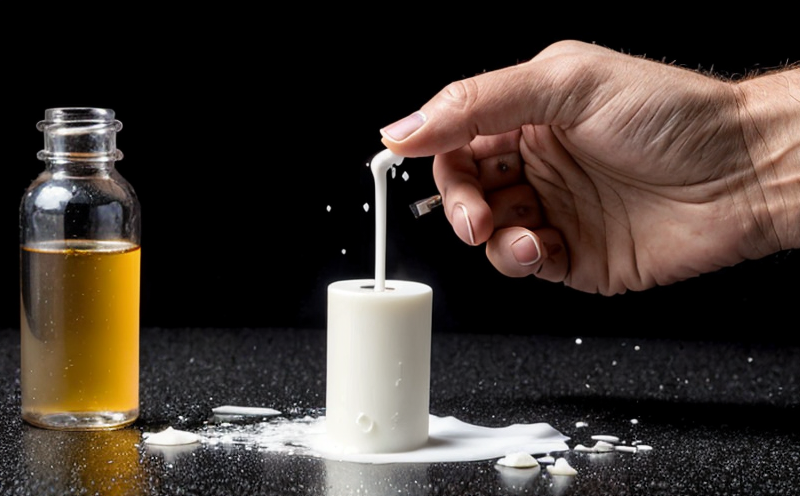USP Syrup Dissolution Testing
The United States Pharmacopeia (USP) Syrup Dissolution Test is a critical quality assurance procedure used in pharmaceutical manufacturing to ensure that active pharmaceutical ingredients (APIs) are effectively released from the syrup formulation into solution. This test is essential for verifying the dissolution characteristics of APIs, which directly impacts drug efficacy and patient safety.
The USP dissolves a fixed amount of API from the syrup sample into a specified volume of solvent at defined temperatures under agitation conditions. The percentage of API dissolved over time is measured to ensure compliance with established standards. This test helps identify potential issues in formulation design, manufacturing processes, and storage stability that could affect drug performance.
The dissolution profile provides insights into the solubility behavior of APIs in different pH environments relevant to human physiology. For instance, syrups are often used for pediatric patients or those with difficulty swallowing tablets. Ensuring accurate API release is crucial, especially considering pediatric formulations must be safe and effective without causing gastrointestinal distress.
The USP dissolution test typically involves measuring the amount of API dissolved at predetermined time intervals (e.g., 15 minutes, 30 minutes, and 60 minutes). These data points are then plotted against time to generate a dissolution profile. The profile helps in determining whether the syrup formulation complies with USP guidelines for release rate.
Understanding the dissolution characteristics of APIs is vital because it affects drug absorption rates and bioavailability. For instance, if an API does not dissolve sufficiently within acceptable limits, it may lead to incomplete absorption, resulting in suboptimal therapeutic effects or even adverse reactions. Compliance with USP standards ensures that formulations are consistent across batches and meet regulatory requirements.
The testing process involves precise preparation of the syrup sample, ensuring accurate weighing and volume measurement. The sample is then placed into a dissolution apparatus where it is subjected to controlled temperature and agitation conditions. Real-world usage notes suggest that this test is particularly important for oral syrups used in clinical settings where patient compliance can be challenging.
Compliance with USP standards not only enhances product quality but also ensures patient safety by reducing the risk of ineffective treatment or adverse events. Regulatory bodies worldwide, including the FDA and EMA, rely on such tests to assess drug quality. This underscores the importance of adhering to these standards in pharmaceutical manufacturing.
In conclusion, the USP Syrup Dissolution Test is a cornerstone of quality assurance in the pharmaceutical industry. It ensures that APIs are effectively released from syrup formulations, thereby enhancing drug efficacy and patient safety. By following established protocols and using state-of-the-art instrumentation, laboratories can provide reliable and accurate results that meet regulatory standards.
Why Choose This Test
- Ensures consistent API release from syrup formulations
- Complies with international pharmacopeial guidelines (USP)
- Provides insights into formulation design and process optimization
- Enhances patient safety by reducing the risk of ineffective treatment
- Sustains regulatory compliance, facilitating market entry
- Promotes consistency across manufacturing batches
- Aids in identifying potential issues during storage stability testing
The USP Syrup Dissolution Test is a robust tool for evaluating syrup formulations. It helps manufacturers identify formulation strengths and weaknesses while ensuring that the final product meets stringent quality standards. This test is particularly valuable for companies aiming to enhance drug efficacy and patient safety.
Customer Impact and Satisfaction
The USP Syrup Dissolution Test plays a pivotal role in enhancing customer satisfaction by ensuring that pharmaceutical products meet the highest quality standards. By providing reliable and consistent results, this test helps manufacturers build trust with healthcare providers and patients. Regulatory compliance is crucial for gaining market acceptance and maintaining a positive reputation.
- Facilitates smoother interactions between healthcare providers and patients
- Reduces complaints about ineffective treatments or adverse events
- Promotes long-term customer loyalty through consistent product quality
- Supports the development of safe and effective pediatric formulations
- Aids in meeting the stringent requirements set by regulatory authorities
- Encourages transparent communication between manufacturers and healthcare professionals
The test results can also serve as a valuable resource for R&D teams to refine formulation processes, leading to improved product performance. By focusing on quality assurance through this test, pharmaceutical companies can contribute significantly to the overall well-being of their customers.
Environmental and Sustainability Contributions
The USP Syrup Dissolution Test contributes positively to environmental sustainability by promoting efficient resource usage and reducing waste. By ensuring accurate API dissolution, this test minimizes the need for additional testing or rework, thereby conserving resources and energy.
The use of advanced dissolution apparatuses equipped with precise temperature control further enhances efficiency. This not only reduces the carbon footprint but also optimizes laboratory operations. Compliance with USP standards ensures that manufacturers adhere to best practices in quality assurance, which can lead to broader environmental benefits.
In addition, the test supports sustainable development by fostering innovation and continuous improvement in pharmaceutical manufacturing processes. By adhering to these stringent guidelines, companies can contribute to a more resilient healthcare ecosystem, ultimately benefiting both patients and the planet.





